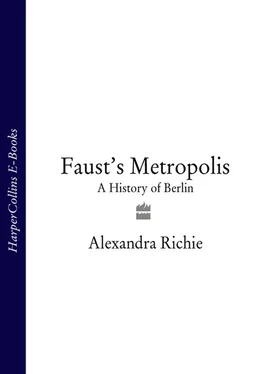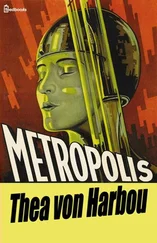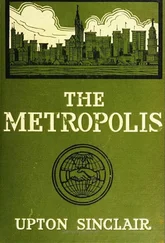Until now the Slavic Hevellians had been spared the Christian onslaught but the peace ended suddenly in 948. In that year Otto I crossed the Elbe and attacked their capital Brennobar. The heathen settlement was overrun, Slavic protestors were killed, the celebrated pagan shrine was levelled and a bishopric was put in its place. The town was given a new name: Brandenburg.
Brandenburg was turned into a centre of evangelizing activity. Christians quickly moved in, rounded up the local Slavs and forced them to convert at swordpoint. Otto was so successful in his drive eastward that by the end of his reign he had reached the river Oder, dividing the new lands into Marks. 34The area which would become the Nordmark or North Mark and which encompassed the territory of the Hevellians and the Sprewan Slavs extended from the Elbe to the Oder and from Lausitz to the Elbe – Peene line. Furthermore Otto finally defeated the troublesome Magyars at the Battle of Lechfeld in 955, a victory which brought him such fame that he was henceforth referred to as Otto the Great. Rather than protect his conquests in the north, however, Otto set out on three separate campaigns in Italy and in 962 marched to Rome, where the Pope placed the magnificent gold and gem-encrusted crown of the Holy Roman Emperor on his head. But his victory did not bring the desired peace. Otto I died in 973 and, rather than return to the north, his successor Otto II remained in a bid to drive the Greeks and Saracens from Italy. In 982 he faced a humiliating defeat at the hands of the Muslims of Sicily. It left him gravely weakened, and the newly won lands and new bishoprics at Havelberg and Brandenburg were left undefended. And it was then that the Slavs struck back.
The Slavs of the North Mark had been resentful at the coming of the Christians and of the strange new religion which forbade the worship of their fertility goddesses and the shrines to the spirits of nature. Worse still, the new masters had forced them to pay tributes to the Germanic religious fortresses, payments which were extracted by sheer force if necessary. When the Slavs heard the news of Otto II’s disastrous defeat in Italy they were encouraged to take up arms. The response was the Great Slav Uprising of 983.
The revolt was led by the Hevellians, who were determined to retake their holy capital of Brennabor. In a well-orchestrated attack they set upon the city, sacking the new Ottonian church and massacring the Christian inhabitants there. On 29 June 983 the bishopric of Havelberg was destroyed, and the small church at the Spandauer Burg was decimated three weeks later. The Slavs then swept through the Mark, killing monks and settlers. By July most German outposts had been razed to the ground, and although a handful of bishops dared to remain they were forced into hiding and lived without cathedrals or diocese. 35The rest of the population reverted to their pagan practices. The Germanic Christian drive eastward had been halted and Magdeburg once again became the true boundary of the German Christian world. Otto was devastated and died in 983 in the knowledge that he had failed at his most important task – the defence of Christendom against the heathen. The unhappy emperor was buried at St Peter’s in Rome. Unfortunately for the Slavs in the North Mark, Otto’s death was not the end of the threat to their way of life. The leader of a completely different area had also recently undergone conversion to Christianity and was now eager to expand his territory in the name of the Church. This place lay not in German lands, but far to the east of the Spree and Havel in a place which would soon be known as Poland. The Slavs of the Berlin area were now sandwiched between two powerful Christian blocs. The race was on to see which side could conquer it first.
The coming of Christianity to Poland was of immense importance not only to the Slavs of the Berlin area but to the unfolding history of the entire region. The presence of a vast Catholic kingdom to the east of Germany would shape the history of central Europe and of Berlin for centuries to come, not least because of the rivalry which even now emerged between the German Christians and their Polish counterparts.
The Germans had hoped to Christianize all of northern Europe by pushing eastward from Magdeburg and on to Kiev Rus, knowing that under the Ottonian system the establishment of religious centres was inextricably linked to political conquest. The sudden emergence of Poland foiled their plans. The early history of the Piast dynasty remains obscure but by the third quarter of the tenth century the Polish ruler was rising to prominence as quickly as the Saxon rulers had in the west. The first Polish prince, Mieszko I, was keen to extend his power throughout the region. 36This posed a problem for the Germans, and in particular for Otto I.
When Otto made Magdeburg an archbishopric in 961 he had seen it as the base from which all territory from Saxony to Russia would be Christianized, a move which would in turn have brought all of east central Europe under German control. Mieszko objected. Not only did he want to prevent German meddling in his affairs; he also wanted to increase his own territory. The first Polish ruler was still relatively weak compared to his powerful Saxon rival and had to tread carefully; indeed at one point he only managed to forestall an invasion by agreeing to accept German Christian missions on his land. 37To Otto’s fury, however, in 966 he did the unthinkable. Instead of accepting Christianity from Germany Mieszko turned instead to Bohemia. By adopting Christianity from the south he had in one momentous act prevented the religious, administrative and political domination of Poland by the Holy Roman Emperor. Henceforth – to the annoyance of the Germans – Poland would grow to become an entirely separate and independent entity which would never succumb to the German vision of the Drang nach Osten – the idea that they had a civilizing mission in the east.
For a time it looked as if the religious compromise between Poland and the Germans would hold. The new Holy Roman Emperor Otto III, who was half Greek and had been brought up in Italy, regarded his own people as somewhat primitive and was not obsessed by German domination of the east. On the contrary, he had been deeply shaken by the Slav uprising and by the Borderlands between Germany and Poland, 10 th–11 thCentury disastrous campaigns of the 990s and was willing to leave the conversion of the troublesome pagan Slavs in the east to the Poles as long as they joined the confederation of Christian princes under his ultimate control. Unlike his predecessors he had a vision of Europe organized as a hierarchy of kings; indeed a diptych painted at the end of the tenth century shows him receiving the homage of four crowned women: Germany, Gaul, Rome and Slavonia – the Slavic lands. 38He was sympathetic to the idea of Polish independence and, to the fury of leading German ecclesiastics, planned to set up a number of churches there which would be free from all German control.

Such German generosity to Poland is rare in history, but it had in part to do with the Polish response to a particular event which had deeply affected Otto III. This pious emperor had been a friend of Adalbertus, the former bishop of Prague. In 996 Pope Sylvester I had sent Adalbertus on a mission to convert the fierce East Prussians, and on his journey north that year the new Polish leader Boleslaw the Brave, Mieszko I’s son, generously received him with full honours. The action was duly noted in Rome. Adalbertus continued on to East Prussia where the local tribesmen, who were not keen on conversion, simply murdered him. Rather than ignore his death the Poles purchased his body for a vast sum – its weight in gold – and created a shrine for him at Gniezno. Pope Sylvester I was so impressed by this show of piety that he took the unusual step of canonizing Adalbertus, elevating Gniezno to an archbishopric and creating bishoprics at Wroclaw (Breslau), Kolobrzeg (Kolberg) and Krak–w (Cracow). It was the creation of a new archbishopric which finally severed the Polish Church from control of the German archbishopric at Magdeburg. The Poles now had an independent administration and took to Christianizing the west Slavic tribes with as much gusto as the Germans had done – the great bronze doors of Gniezno Cathedral depict King Boleslaw distributing blessings and assisting at baptisms, while his sword bearer stands beside him ready to strike down those who refuse to convert. 39The Poles were emerging as a powerful Christian country in their own right.
Читать дальше













